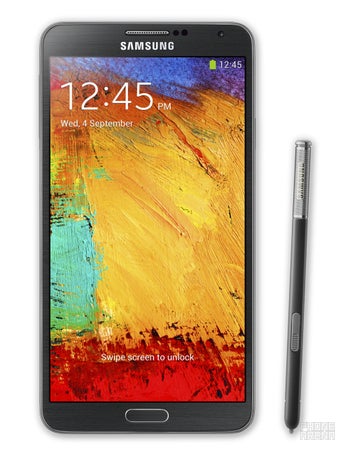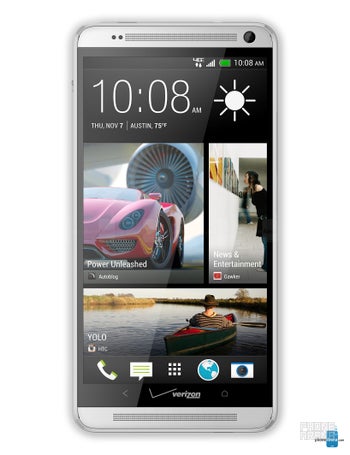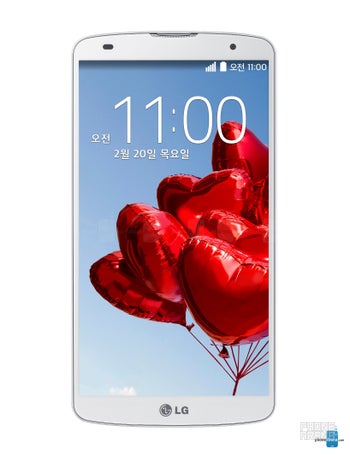LG G Pro 2 vs Note 3 vs HTC One max specs comparison

LG just lifted the veil over its largest phablet to date, the G Pro 2, and the handset is everything that it was rumored to be - large and resolute display, keys on the back, fast Snapdragon 800, generous 3 GB of RAM and a 13 MP shooter with a newer OIS breed.
How does it compare to the other high-end phablets out there? Let's see, on one hand it is taller and somewhat wider than the Note 3, but sports the same slim chassis, and has a 0.2" larger screen to boot, so LG definitely did well here. That's especially visible in comparison with the other brand name 6-incher - HTC One max - which is way taller, wider, thicker and heavier than the G Pro 2 even. Granted, HTC had to accommodate its excellent BoomSound dual speaker system at the front, and a fingerprint sensor on the back, but still. LG and HTC flaunt LCD displays, while the Note 3 keeps it AMOLED, but these three companies have proved they can put excellent panels on their flagships, so you are unlikely to regret your purchase when it comes to screen quality.
In terms of processing power, the G Pro 2 is an exact match to the Note 3, with the fastest current Snapdragon 800 processor, and the record 3 GB of RAM, while the One max makes do with a lower-class Snapdragon 600, and 2 gigs of RAM. The faster phablets also offer the generous 32 GB of internal storage from the get-go, against HTC's 16 GB, but they all have microSD slots for storage expansion - one has to carry all those movies somewhere.
LG G Pro 2 shines in the camera department as well, as it is the only one offering a 13 MP shooter with improved optical image stabilization tech inside, putting an end to blurry shots and shaky footage. The Note 3 also carries an excellent 13 MP unit, but without OIS, while the One max tags along with HTC's UltraPixel shooter that is somewhat light in the detail department, due to its comparatively low resolution.
HTC's phablet excels a tad in the battery capacity department, offering 3300 mAh unit, against the 3200 mAh juicer in the other two, but in reality the difference is likely to come from overall consumption rates, rather than battery capacity. Overall, LG did great with the G Pro 2, offering top-shelf specs in what can be considered a compact body, as much as it is possible with a 6-incher, so it will definitely be on the radar of those looking for a good big-screen handset, unless you are bent on the input options that come with Samsung's Note 3 stylus.
Display
Size
Technology
Super AMOLED
S-LCD 3
IPS LCD
Screen-to-body
74.78 %
70.63 %
74.27 %
Features
Scratch-resistant glass, Ambient light sensor, Proximity sensor
Ambient light sensor, Proximity sensor
Scratch-resistant glass, Ambient light sensor, Proximity sensor
Hardware
System chip
Qualcomm Snapdragon 800 MSM8974
Qualcomm Snapdragon 600 APQ8064T
Qualcomm Snapdragon 800 MSM8974
Processor
GPU
Adreno 330
Adreno 320
Adreno 330
RAM
Internal storage
64GB
32GB
32GB
OS
Android (5.0 Lollipop, 4.4.4, 4.4, 4.3)
Android (4.4.2, 4.4, 4.3), HTC Sense UI
Android (5.0 Lollipop, 4.4), LG Optimus UI
Battery
Capacity
3200 mAh
3300 mAh
3200 mAh
Talk time
the average is 3 h (180 min)
the average is 3 h (180 min)
Stand-by time
the average is 3 days (72 h)
the average is 3 days (72 h)
Talk time (3G)
the average is 0 h (0 min)
the average is 0 h (0 min)
Stand-by time (3G)
the average is 0 days (0 h)
the average is 0 days (0 h)
Stand-by time (4G)
the average is 0 days (0 h)
Music playback
84.00 hours
Video playback
13.00 hours
Camera
Rear
Single camera
Single camera
Single camera
Main camera
Specifications
Aperture size: F2.2; Focal length: 31 mm; Sensor size: 1/3.06"; Pixel size: 1.12 μm
Aperture size: F2.0; Focal length: 28 mm; Sensor size: 1/3"; Pixel size: 2 μm
Aperture size: F2.4; Focal length: 29.22 mm; Sensor size: 1/3.06"
Video recording
3840x2160 (4K UHD) (30 fps), 1920x1080 (Full HD) (60 fps), 1280x720 (HD) (120 fps)
1920x1080 (Full HD) (30 fps), 1280x720 (HD) (60 fps)
3840x2160 (4K UHD) (30 fps)
Recording format
MPEG4, H.263, H.264, WMV
Features
Continuous autofocus, Video light, EIS, Video calling
HDR, Continuous autofocus
HDR
Front
2 MP
2.1 MP
2.1 MP
Video capture
1920x1080 (Full HD) (30 fps)
1920x1080 (Full HD) (30 fps)
1920x1080 (Full HD) (30 fps)
Design
Dimensions
Weight
the average is 5.8 oz (166 g)
the average is 5.8 oz (166 g)
the average is 5.8 oz (166 g)
Materials
Back: Aluminum
Biometrics
Fingerprint (swipe)
Features
Stylus, Interchangeable covers
Touch sensitive control keys
See the full Samsung Galaxy Note3 vs HTC One max vs LG G Pro 2 specs comparison or compare them to other phones using our Specs Comparison tool.















Things that are NOT allowed: